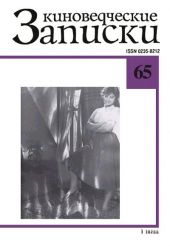 |
 |
I. PROCESS Victoria LEVITOVA. A Possible Future of Russian Cinema, or Unrealized Reality. Analytical review of Russia’s entries in the Moscow Festival’s main program: Aleksei Uchitel’s A Walk, Boris Khlebnikov and Alexei Popogrebskii’s Koktebel, and Irina Evteeva’s Petersburg. EXPERIENCE Irina EVTEEVA. Merging the Documentary, Animation and Fiction. A prominent animator speaks about her work—from her debut piece A Horse, a Violin, and A Bit of Nerves (1991) to the latest film Petersburg (2003),—analyzing the potential of animation’s interaction with documentary and fiction filmmaking within the same filmic space. MUSEUM OF CINEMA Petr BAGROV. Eduard Ioganson and Others. Besides co-authoring Fridrikh Ermler’s Children of the Tempest (1926) and Katka’s Reinette Apples (1926), Eduard Ioganson directed The Crown Prince of the Republic (1934) and On Vacation (1936), two sophisticated lyrical comedies that were quite atypical of the 1930s Soviet cinema. Georgii BAN’KOVSKII and Eduard IOGANSON. The Symphony of Peace, an Animated Sound Film (Publication by Petr Bagrov). The script of the first color film produced at the Leningrad studios (1932). Petr TODOROVSKII: “That film was a powerful impetus…” (Interview by Natalia Mazur). A distinguished Russian filmmaker reminisces about his first film Never (1962), an undervalued milestone in the Soviet cinema of the early 1960s. Georgii DARAKHVELIDZE. A Portrait of the Clown as an Old Man. A comparative analysis of Charlie Chaplin: The Forgotten Years (2003, Switzerland; dir. Feliche Zenoni) and Unknown Chaplin (1980, Great Britain; dir. Kevin Brownlow and David Gill). Vladimir DMITRIEV: “Andre Delvaux Truly Belongs to the Cinematheque.” (Interview by Tamara Sergeeva). A prominent film historian and archivist analyzes Delvaux’s oeuvre and reviews the Belgian director’s retrospective, one of the Moscow Festival’s big successes. LIFE AND ADVENTURES IN CINEMA Vladimir GOLUBEV. Notes of a Cinephile (Part II). A history of cinema from the 1980s up to now, as seen by a film connoisseur (Continued from Issue 64). II. Kalatozov Today: Discussion by Andron KONCHALOVSKII, Aleksandr MITTA, Gleb PANFILOV, and Sergei SOLOVIEV (Moderator: Tamara Sergeeva). Leading Russian filmmakers talk about Mikhail Kalatozov’s contribution to film history and his significance for the contemporary cinema. Mikhail KALATOZOV. Mountain Eagles (Shamil). A 1936 Script (Treatment). (Publication and Introduction by Aleksandr Deriabin). For many years, Kalatozov worked on a script for Shamil, a film which he considered among his most important projects, and which, unfortunately, he was unable to produce. This publication aims to clarify an obscure moment in the filmmaker’s career and, more generally, in the history of the Soviet cinema of the 1930s. “Sex… has exhausted itself and grown old.” Mikhail Kalatozov: Letters from America (Publication, Introduction and Commentary by Sergei Kapterev). Letters sent by Kalatozov to his superiors at the Committee on Cinematography at the USSR Council of People’s Commissars in 1943–1944, during his stay in the United States as “a special representative of the Soviet motion picture industry.” Kalatozov was responsible for the promotion of Soviet cinema in the US market; for the selection of American films for exhibition in the Soviet Union; and for the qualitative upgrading of Soviet-American exchanges in the field of cinema via the establishment of relevant permanent structures and auxiliary services (such as a dubbing studio, regarded by Kalatozov as “a major factor in advancing our films in America.”). EISENSTEINIAN READINGS “…Sergius, Your Loving Son and a Decorator.” Excerpts from Sergei Eisenstein’s letters to his mother, 1919–20. (Publication, Introduction and Commentary by Vladimir Zabrodin). A selection of rare documents providing new insights into the formation of Eisenstein’s personality and artistic principles. (Continued from Issue 64). THEME FOR EXPLORATION Rashit YANGIROV. “Mastering the Gift of Speech:” A “Russian Accent” in French Cinema’s Early Sound Period, 1929–32. (To Be Continued). The author looks into the early efforts in the sphere of film sound undertaken by the Russian йmigrй community in France (Nikolai Evreinov, Dmitrii Merezhkovskii, et al.) in collaboration with Abel Gance and other French filmmakers. Nina CHERNOVA and Vasilii TOKAREV. Red Cavalry: A Cinematic Raid into Oblivion. Notes on the History of Soviet Cinema,1938–41. A detailed historical study of the fate of Red Cavalry, an unreleased film scripted by Vsevolod Vishnevskii and directed by Efim Dzigan. A TOPIC FOR RESEARCH Dragan KUJUNDZIC. Devisions, Inscryptions, and Scenotaphs: Kieslowski and Mourning. A theoretical study of deeper motifs and themes in Krzysztof Kieslowski’s Double Life of Veronique and Three Colours trilogy. Irina SHILOVA. Two Versions of One Film: Can a New Technology Generate a Novel Narrative Style? On the artistic possibilities of digital filmmaking in the Russian-language (A Blooming Hill in the Midst of a Barren Field) and English-language (Anna’s Hill) variants of Andrei Eshpai’s film.
|
|
 |
||||||||||||||||||||||||||||||||||||||||||||||||||||||||||||||||||||||||||||||||||||||||||||||||||||
| « | » |
является незаконным.



